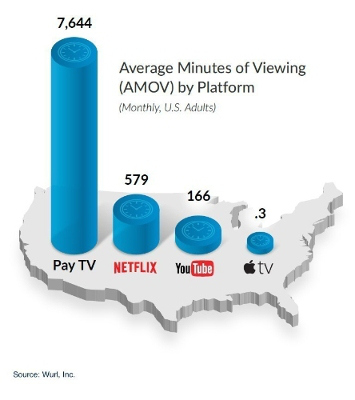 Measured by minutes of viewing time, traditional pay-TV accounts for 80% of viewing video time in the US.
Measured by minutes of viewing time, traditional pay-TV accounts for 80% of viewing video time in the US.
This is according to data from a new video index that compares the usage of major video viewing services based on publicly available data. The index, referred to as AMOV, measures the average minutes of viewing by US adults on each video platform, taking into account both usage (minutes of viewing) and reach (percentage of US adults that use the service). The AMOV Index measures viewing on popular services like YouTube, Netflix, pay TV, Apple TV and many others, and is an initative of Wurl, a streaming video platform for pay-TV.
The growing use of streaming video services, a proliferation of new devices for video viewing, and the declining use of pay-TV have made it increasingly difficult for video publishers and advertisers to analyse the relative importance of each video distribution platform.
“The importance of any video distribution platform is directly related to how much it’s used. Generally available information about real usage is difficult to find, confusing and in some cases misleading,” said Sean Doherty, CEO and co-founder of Wurl, Inc.
“To make informed decisions, market participants need a standard way to quantify penetration-adjusted usage for any video service.”
While some platforms have a large installed base but very low viewing time (e.g., smart TV video portals), other platforms have high viewing time but a small installed base. Market participants need a reliable yardstick like AMOV that takes into account how many consumers use a service and how much they use it. For example, a service that’s used ten minutes per month by 65% of US adults would receive an AMOV of 65 minutes per month.

